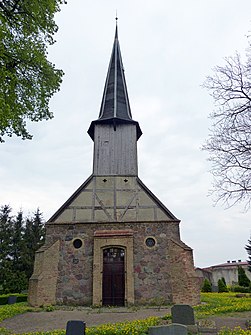Stonemason
|
Stonemason
Community neetzow-liepen
Coordinates: 53 ° 51 ′ 36 " N , 13 ° 26 ′ 14" E
|
|
|---|---|
| Height : | 3 m above sea level NHN |
| Incorporation : | June 13, 1999 |
| Incorporated into: | Neetzow |
| Postal code : | 17391 |
| Area code : | 039723 |
Steinmocker is a village in the Vorpommern-Greifswald district . It is part of the community of Neetzow-Liepen .
history
An early settlement is documented by a large number of Bronze Age (1800 to 600 BCE) barrows, so far 12 barrows have been discovered in the heather wood, of which 3 are rare stone barrows. This special shape is probably due to the wealth of stones in the area. At Zarrentin / Jarmen, an example of a cairn grave is shown in an archaeological reconstruction.
Steinmocker was mentioned in 1454 as "Moker by dem Krine", in 1618 as "Steinmucker" and from 1698 as "Steinmocker". This is a Slavic-German hybrid form of the name - Stein = German as stone and Mocker = Slavic for "moist". The moraine landscape is characterized by brooks, brooks and boulders (some of which are made of stone bars).
Since the first half of the 14th century, the von Winterfeld family belonged to Steinmocker. In 1723 Georg Levin von Winterfeld received the estate as an Allodium . Philipp Otto von Winterfeld had been the landlord since 1764, but in 1805 he was the last winter field in the region to sell to von Ramin . He in turn sold the property to the economist Holtz in 1842. In 1851 Wilhelm von Kruse rounded off his large estate with a stone mason on Neetzow .
The Steinmocker manor district had 16 houses and 13 farm buildings with 169 inhabitants in 1865. The separately designated farming village had at the same time: 1 church, 1 school, 1 forge, 3 jugs, 7 houses and 9 farm buildings. It had 45 inhabitants and 4 farms, which are included in the numbers.
There was an inn at Steinmocker, which was considered an independent village with the name "Mantzelshof" (also Mentzelshof) and where a Vorwerk was also created, but which belonged to Gut Klein Below as a pertinence. According to the Prussian original table sheet from 1835, the place consisted of only one unmarked building on the country road between Steinmocker and Krien. This place was first mentioned in 1865 by Berghaus, but the jug was then built over with the Vorwerk, so the name also disappeared, it was only referred to in the measuring table sheets 1880 and 1920 as "zu Steinmocker". Later it was called "Steinmocker-Dismantling", "Steinmocker-Extension" and "Steinmocker-Vorwerk".
Steinmocker can be described as a street village, although the dominant estate and the row of cottages mean that a different shape than Gutsdorf is possible. The estate is still relatively complete.
The peculiarities associated with the name of the place are the large boulders:
- Giant stone southwest of the village at the end of the so-called wire paddock,
- Giant stone in Steinmocker's wood, 20 m from the edge of the forest, about 500 m as an extension of the paddock (southwest of Jarmen).
The two stones are linked by a legend. The stone in the block-rich wire paddock, an extensive pasture, is freely accessible from all sides and has a volume of around 10 m³. Unfortunately it was split into four parts by wedges. The gneiss block is interspersed with orthoclase phyroblasts 1–2 cm in diameter. Its length is 3 m, width and height each 2.50 m. Twice as large (20 m³ volume) and completely undamaged is the second giant stone, a coarse-grained granite with bluish quartz, somewhat hidden in the forest. Its origin from Småland (Sweden) can be considered certain. It measures 5.10 m in length, 3.40 m in width, 2.40 m in height and has a circumference of 13 m. The legend relates the following: “In ancient times there were two giants, one in the Anklam area, the other in the Demmin area. They got into an argument and threw those big stones at each other. But the stones were too heavy, so that they fell down at Steinmocker and didn't even reach each other. "
On April 1, 1937 Steinmocker was forcibly incorporated into the municipality of Krien . On August 1, 1946, the incorporation was reversed and Steinmocker existed again as an independent municipality. On June 13, 1999, the Steinmocker community was incorporated into Neetzow.
Attractions
- Church stonemason from the 15th century
- Steinmocker manor complex, manor house from around 1800
literature
- Manfred Niemeyer: East Western Pomerania. Collection of sources and literature on place names. Vol. 2: Mainland. (= Greifswald contributions to toponymy. Vol. 2), Ernst-Moritz-Arndt University of Greifswald, Institute for Slavic Studies, Greifswald 2001, ISBN 3-86006-149-6 . Pages 88, 93, 100, 127
- Heinrich Berghaus : Land book of the Duchy of Pomerania and the Principality of Rügen. Part II, Volume 1, Anklam 1865 ( online )
Individual evidence
- ^ Manfred Niemeyer: Ostvorpommern. Collection of sources and literature on place names. Vol. 2: Mainland. (= Greifswald contributions to toponymy. Vol. 2), Ernst-Moritz-Arndt University of Greifswald, Institute for Slavic Studies, Greifswald 2001, ISBN 3-86006-149-6 . Page 127
- ^ Heinrich Berghaus : Land book of the Duchy of Pomerania and the Principality of Rügen . Part II, Volume 1, Anklam 1865, p. 376 ( online )
- ↑ StBA: Changes in the municipalities in Germany, see 1999
